Taking a leaf from a sweet post of Rebecca’s Texas Garden, I am currently nannying Monarch caterpillars in my house. Monarch-sitting has its brief, dramatic moments, but most days pass without much but eating.
And eating.
And eating.
That’s how we grow, right? A Monarch will gain about 2000 times its birth weight before it begins the process of transforming into its adult self. And all that eating produces caterpillar poop, which polite people call frass.
I am keeping the frass tidied up. Sort of.
Continuing with this Lepidoptera saga of moving some milkweed with accompanying Monarch larvae into my son’s recently vacated room,
…there is action to report–Monarch goings on, if you will. A couple of the caterpillars were quite large, nearing pupation stage when I settled them from the garden. Within two days, the first monarch completed its 4th instar (molt of the exoskeleton) and he’d vacated the bunches of milkweed to find a place for the final transformation, the chrysalis. I realized there was one caterpillar missing and that he’d probably crawled away to pupate and I launched a search mission. I looked, knowing he hadn’t gone far, but I couldn’t find him. I counted and recounted caterpillars and was sure he wasn’t amongst the leaf chompers. He’d pupated, but where??
There he is!
When I was downloading photos for this post, I noticed in the photo below this first caterpillar crawling along the desk. He found the right spot on the statue of Buddha.
This guy was not far behind in the pupation process.
I observed his disembarkation from the milkweed buffet and for a few minutes, followed his wanderings as he was (I assumed) looking for the perfect place to pupate. He ended up here.
Approaching his last instar this Monarch larva formed into the signature “J” shape for at least twelve hours. I knew the “J” would become a bright green chrysalis sometime in the evening and I knew that the chrysalis transformation would happen in a short amount of time–minutes probably. I came home from an evening out, flipped the light on and observed this wet, glistening chrysalis in major Monarch writhing.
Moving like a green belly dancer, all sparkles and gyrations, the chrysalis was formed within a few minutes. Afterward, the chrysalis calmed, dried, and hardened. During the J process, he attached himself firmly to the corner of the window with a silk thread and there, will pupate until emergence.
I think the caterpillars that have pupated are all males. Looking at this excellent photo from monarchwatch.org, you can see the difference in a pupa between a female and male. In real-time with my chrysalides, neither my eyes, nor my photographic abilities match that photo, but since I can’t see the line that is indicative of a female, I’m guessing boys so far. I’ll know for sure once they are adults, because that’s much easier to discern.
The remains of his last larval molt, dropped to the window sill.
Another example of molted exoskeleton.
The instar process has repeated for this one,
…and for this one.
I was keeping a keen eye on this guy, on and off, knowing the thing was going to happen. You can see the chrysalis green on the curve of the “J.
Notice the drops of liquid.
Late Tuesday afternoon, I checked him, left to tend to something else, came back within 20 minutes and found the fully enveloped chrysalis, (left).
Drat! I missed it!
There are a couple of other caterpillars, still eating and growing. I expect the first adult to emerge late this coming weekend or early in the week.
There are those who would question the wisdom of my efforts. I question whether bringing them in was a wise move. Should the larvae have remained on the milkweed to either overwinter or die naturally? Should I even grow Tropical Milkweed in my gardens as it’s not native here in Austin? There is preliminary evidence that the overuse of Tropical Milkweed (which seems to be the most successful large-scale milkweed grown for the nursery trade) in well-meaning, but misguided efforts to help Monarchs, may be interfering with their migratory patterns and possibly causing some disease problems. All of this is valid and I was aware these issues when I clipped the milkweed with the attached caterpillars and brought them indoors. I now hold these late season larvae captive and they are growing to adulthood. The next decision I make will be whether to release them and hope they can live to a ripe old age, nectaring on what’s available. They probably can’t make it to Mexico, but I’m sure they’ll try. Or, to keep them captive, safe and well-fed until they die of old age after the 5 or 6 weeks of their lives.
I guess the takeaway here is: don’t mess with Mother Nature, there are always unintended consequences.

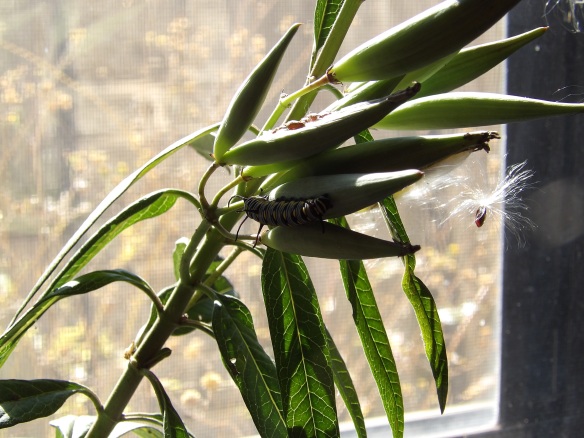
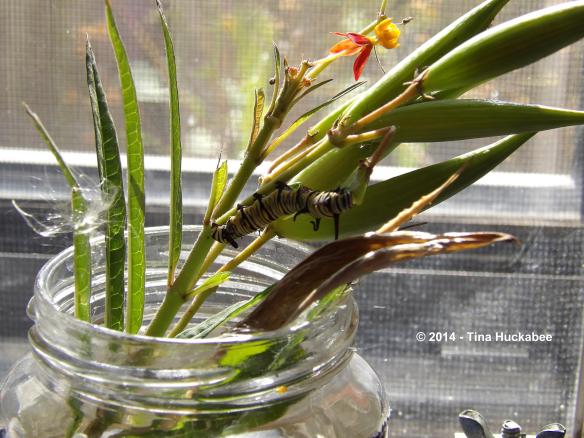
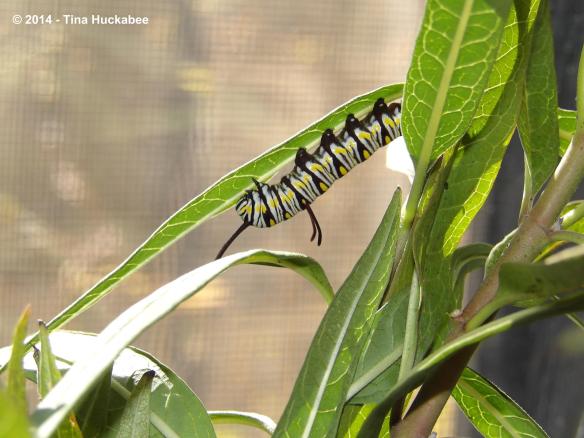


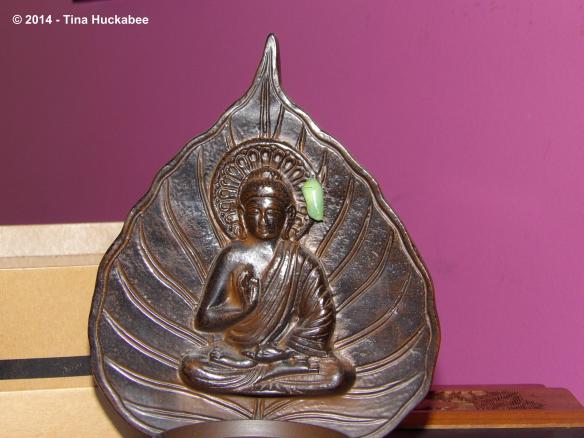

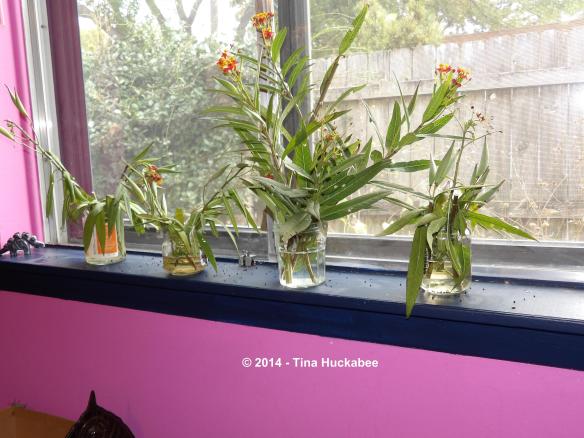




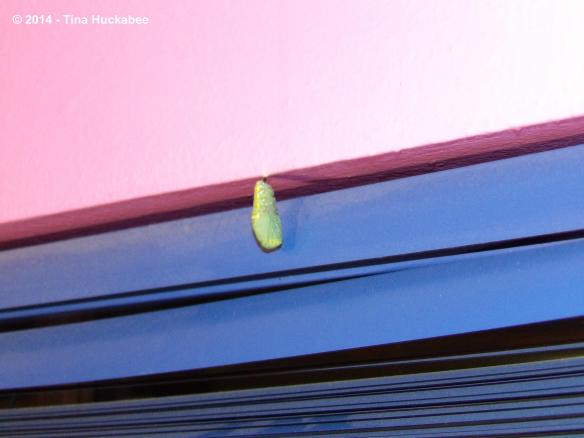
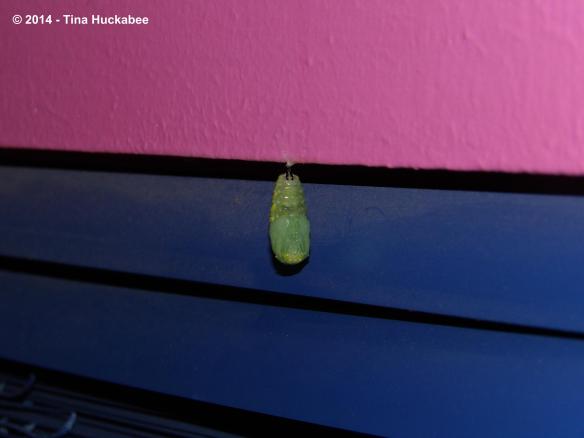





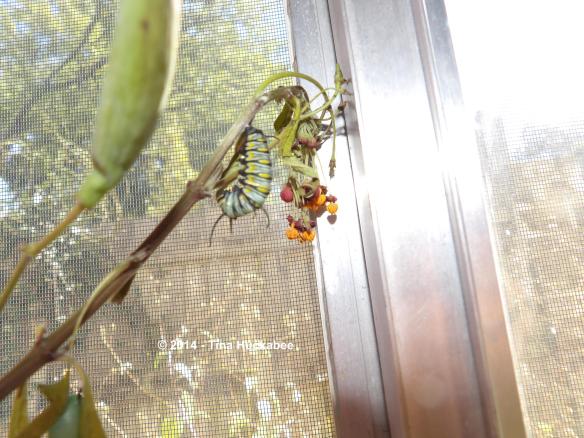
A wonderful post, absolutely fascinating. And great photos.How exciting to watch all the stages close up. And I learnt a new word ‘ frass’. Does that only apply to caterpillar poo?
LikeLike
It is interesting to observe the phases of development. In the garden or along the hiking trail, all one glimpses are the moment-in-time shots. Frass. Insect poop. Frass sounds much nicer, don’t you think? 🙂
LikeLike
I have more free time than many folk, and gardening is slow currently due to a visiting puppy. Which might explain why the other day I was thinking to myself, if I had monarchs to bring in I definitely would. I labored under the delusion that I could “catch” them at some key moment. Which probably means that I would A) spend way too much time staring at them, holding my camera and B) miss the exciting parts anyway.
All of which is a (really!) long way of saying…wow. WOW! You (and Rebecca) are blowing me away with your accounts and photographs of monarch mommying. I am more determined than ever to get antelope milkweed going now, even if it means taking other plants out to make room.
LikeLike
Ha! It’s true that often when trying to ‘get the shot’ you end up missing the action. It’s been interesting and instructive, this nannying project. I agree that more of what’s native in milkweed is a must–it’s just so hard to find. Lucky you, btw, to have a puppy visiting. Such nice energy, those~
LikeLike
I love this project. Beautiful photos and it is so amazing to witness even vicariously. I don’t think you need to worry at all. If you release them outside when it is cool they will just fly south. It really is a stimulous response kind of thing with insects. It is well known that temperature and prevailing winds trigger migration. Any anxiety about growing tropical milkweed I think needs to find a proper context: imagine living in London during a plague year. There are massive deaths all around you and some guy is passing out blankets ridden with fleas. Then someone comes along and starts a debate about whether linen or cotton bandages are best for wrapping buboes. Which issue should demand our attention? That article from the New York Times just makes me so angry. Of course growing native milkweed is better. No news there. But worrying about a -potential- problem of growing tropical milkweed in comparison to what we really know is causing monarch decline is kind of outrageous.
LikeLike
Well, thanks Debra for the virtual thunk on my head. You’re right, of course and sometimes too much information is not such a great thing. It was the New York Times article I’d read just prior to this post, but there has been other information that I’d read before. It’s preliminary though, this thought that the tropical milkweed might (*might*) be some sort of problem. You analogy is appropriate–and we know, absolutely know, what the real threats are to the Monarchs: GMO seeds in the “food belt” of North America which encourage the massive use of herbicides, thus killing off thousands of square miles of pollinator plants (native milkweed included), habitat destruction in Mexico (though that’s under some control now), and the increasingly extreme weather patterns. NOT, whether you and I plant tropical milkweed in our gardens. Thanks for the reminder!
LikeLike
Thanks for the blog love – it was so much fun rearing my cats this year. I can’t wait to try it again next year…and hopefully with a few more cats. I can’t believe how many you have – quite impressive! And the Buddha-fly is awesome. I only have tropical milkweed planted in my garden and wasn’t aware of some of the negative impacts it has on the Monarchs. Have you purchased any native varieties? If so, where did you get them, and do the Monarchs like it? Good luck with the rest of your rearing and release decision!
LikeLike
Well, thank you, Rebecca for the inspiration. It’s been fun and very, very interesting. I don’t think tropical milkweed is bad, it’s just that (obviously) the native-to-an-area is better. The problem is that it’s not all that available. I think the tropical is the easiest for large-scale operations to grow and sell. But I think that Debra (see comment above) is correct: this is what we can do and if you’re interested in gardening for wildlife, this is the choice–tropical milkweed is it. Also, I think that the tropical milkweed “issues” are maybe(?) a bigger problem further north–we don’t want Monarchs hanging around and eating, we want them to migrate south at the proper time.
I’m fairly sure I’m going to release. I know they won’t make to to Mexico, but it’s likely they’ll have enough to eat in the next 5-6 weeks and they’ll do what they’re driven to do–migrate.
LikeLike
Oh my gosh! I was so excited reading this post. I regret not bringing in the cats I found out in the garden and at the cottage. I’ll plan to do it next year. But it sure was fun watching one grow in the sheltered spot in my garden. You must be so thrilled to have so many! Do keep us posted about their progress. I would think if you released them on a warm day they would have no trouble making the journey. If you haven’t seen it already, check out this page: https://www.learner.org/jnorth/monarch/fall2014/c100914_late.html. Cheers!
LikeLike
Wow! I checked out that site–thanks. That was one cruising monarch! I am going to release and it will start next week. There’s still lots blooming here and even more in South Texas. Maybe they will make it!
I brought in 8, one has died and I found another, so back up to 8. One of those guys has several lives; more about that later….
LikeLike
Love this idea of ‘nannying’ monarchs. We occasionally find butterflies ‘asleep’ around the house,
LikeLike
I think it’s probably not uncommon, especially in colder climates, to find insects hibernating in a nice, warm house. I often find lady bird beetles in the winter in my house.
LikeLiked by 1 person
Thank you for posting this, it is fascinating. A friend once gave me a chrysalis of a swallow tail butterfly, I waited months for it to pupate, but it was worth the wait to see the newly emerged bright colours on the butterfly. What will you do with the butterflies when they emerge?
LikeLike
Hi Christina! Thanks for stopping by! It’s fascinating and a very easy project to nanny butterflies indoors, then release. They’re very adaptable where they want to pupate. I plan to release the monarchs. As long as we don’t have a hard freeze in the next month or so, there are still blooming things in Central Texas and definitely south of where we live. They will migrate south–they’re genetically programed to do that. I doubt they’ll actually make it to Mexico, but they can nectar on what’s available.
LikeLiked by 1 person
I feel like a real jerk here but the Queen caterpillar has three sets of protuberances–two sets of filaments, one set of antennae and the monarch has two. I missed it too until someone who knows a ton pointed it out to me. So you have a certain number of queen cats which look a lot like monarchs… Michelle
LikeLike
That’s interesting and I guess what it means is that my friend, Mr. Nine Lives is a Monarch and the others are all Queens. Interestingly, I haven’t had that many Queens this year, a few, not many. I witnessed a Monarch laying eggs, so I assumed all the larvae were Monarchs. There was a Queen at about the same time, toward the end of the Monarchs flight through here, so maybe she’s the parent. One way or the other, I’ll know in the next few days. Stay tuned!
LikeLike
That’s interesting and I guess what it means is that my friend, Mr. Nine Lives is a Monarch and the others are all Queens. Interestingly, I haven’t had that many Queens this year, a few, not many. I witnessed a Monarch laying eggs, so I assumed all the larvae were Monarchs. There was a Queen at about the same time, toward the end of the Monarchs’ flight through here, so maybe she’s the parent. One way or the other, I’ll know in the next few days. Stay tuned!
LikeLike
Pingback: And…They’re Off! | My Gardener Says…